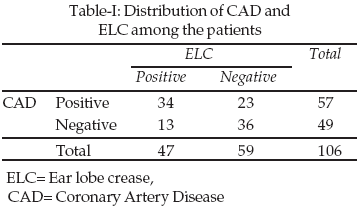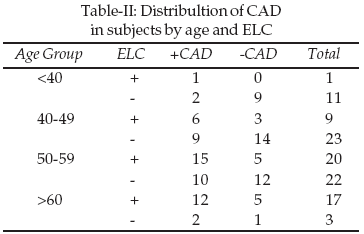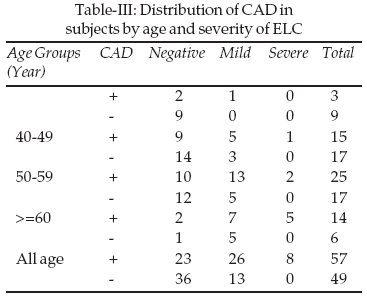|
|
||||
|
Published by : PROFESSIONAL MEDICAL PUBLICATIONS |
||||
|
ISSN 1681-715X |
||||
|
||||
|
- |
||||
|
ORIGINAL ARTICLE |
||||
|
- |
||||
|
Volume 24 |
July - September 2008 |
Number 4 |
||
|
|
||||
|
||||
|
|
||||
|
Published by : PROFESSIONAL MEDICAL PUBLICATIONS |
||||
|
ISSN 1681-715X |
||||
|
||||
|
- |
||||
|
ORIGINAL ARTICLE |
||||
|
- |
||||
|
Volume 24 |
July - September 2008 |
Number 4 |
||
|
|
||||
|
||||
Earlobe crease and coronary artery disease
Payman Salamati1, Iraj Nazeri2,
Mehdi Alehossein3,
Kambiz Sotoudeh4, Ahmad Rezaee5
ABSTRACT
Objectives: Diagonal ear lobe crease (ELC) has been introduced as a diagnostic physical sign for coronary artery disease (CAD) and the aim of this study was to evaluate the association between ELC and CAD in Iranians.
Methodology: In a cross- sectional study, 106 consecutive patients, referred from cardiologists for angiography, were studied for presence of ELC and CAD in four academic hospitals in Tehran. ELC categorized based on Ishii classification and CAD defined as at least 50% narrowing in one of the three major epicardial vessels.
Results: The average age in 70 men and 36 women was 50.14Ī14.11 years. Based on angiographic results, patients were divided in two groups. In 57 patients of CAD positive group, 34 patients had ELC and in 49 patients of CAD negative group only 13 patients had ELC. (P<0.05) After adjusting for age, ELC was a significant predictor of CAD (P<0.05). The severity of ELC (size and unilateral or bilateral) was significantly related to presence of CAD (P<0.05). The observed sensitivity, specificity, positive predictive value and negative predictive value of ELC for diagnosis of CAD were in the following order: 59.6%, 73.5%, 72.3% and 61%
Conclusions: In Iranians, the presence of ELC is associated with CAD.
KEY WORDS: Angiography, Coronary Artery Disease, Diagnostic Test.
Pak J Med Sci July - September 2008 Vol. 24 No. 4 600-603
How to cite this article:
Salamati P, Nazeri I, Alehossein M, Sotoudeh K, Rezaee A. Earlobe crease and coronary artery disease. Pak J Med Sci 2008;24(4):600-3.
1. Payman Salamati,
Assistant Professor of Community Medicine,
2. Iraj Nazeri,
Professor of Cardiology,
3. Mehdi Alehossein,
Assistant Professor of Radiology,
4. Kambiz Sotoudeh,
General Practitioner,
5. Ahmad Rezaee,
Community Medicine Specialist,
1-4: Tehran University of Medical Sciences,
Bahrami Hospital, Shaheed Kiaee St,
Damavand Ave,
Tehran 16417, Iran.
Correspondence
Payman Salamati,
E- mail: psalamati@tums.ac.ir
* Received for Publication: February 20, 2008
* Accepted: June 1, 2008
INTRODUCTION
Epidemiologic studies of risk factors for coronary artery disease (CAD) have provided many challenges in recent decades up to now. All of the known risk factors were due to evaluation of patientís history, laboratory or para clinical tests. However, the association between the presence of diagonal earlobe crease (ELC) as a physical sign and coronary artery disease (CAD) was first reported by Frank in 1973.
1 Afterwards, many studies presented ELC as a marker for coronary artery disease.2-7However, several reports rejected the value of the sign or totally denied the association.
8-10 The pathophysiologic link between ELC and CAD has been difficult to ascertain. The occurrence of various earlobe shapes differs according to race. Published data showed more frequency of ELC in countries with high prevalence of coronary artery disease (CAD) - associated deaths such as England and usa. Reversely, less frequency of ELC was in the areas with low prevalence of CAD such as Hawaii and Poland.11-12Anatomically, both the earlobe and heart are supplied by the "end arteries" without the possibility for collateral circulation. Meanwhile, there is generalized loss of elastin and elastic fibers seen in biopsy specimens taken from the earlobes of persons who have ear lobe crease reflecting microvasculature disease that is also present in the coronary bed.
13There are two important pitfalls in most previous studies about association of CAD and ELC: not using coronary angiography as a gold standard test of diagnosing CAD and not controlling the role of age as a confounding factor. Furthermore, in some references, association between ELC and CAD is ruled out in some ethnic groups such as Eastern and Indian- Americans or syndromes such as Beckwith- Wiedeman.
13,14As far as we know, there is no previous study about association of CAD and ELC in Iran. In this study, we evaluated the association between ELC and CAD proved by coronary angiography in Iranian patients.
METHODOLOGY
In a cross sectional study 106 consecutive patients were referred by cardiologists to four academic hospitals in Tehran for coronary angiography: Imam Khomeini Hospital 50 patients, Shahid Rajaei Heart Center 28 patients, Shariati Hospital 26 and Taleghani Hospital two patients. The examiner assessed the earlobe for the presence of a clear- cut diagonal crease of the lobular portion of either auricle without knowing the results of the coronary arteriographies.
The presence of ELC was described and classified according to Ishii classification.
5 The presence of ELC was defined as a deep crease or wrinkle present on earlobe, which was graded two if it was deep enough with clear cut diagonal crease reaching to both borders of the earlobe. Point 0 was for no evidence of crease and intermediate cases considered one. The points of the two ears added together and stratified patients to three groups:Group 1: NO ELC (point 0)
Group 2: Mild ELC (point 1 or 2)
Group 3: severe ELC (point 3 or 4)
Gold standard test of CAD was coronary angiogram which was performed in all participants. CAD was defined as the presence of angiographic coronary stenosis >50% of the luminal diameter in at least one of the three major epicardial arteries. The coronary cineangiograms were analyzed by experienced cardiologists unaware of the presence of the ELC. Statistical Analysis was performed using Chi-square, Cochran and Mantel- Hanzel tests with SPSS software Version 11.
RESULTS
The study population consisted of 70 men and 36 women whose mean age was 50.14Ī14.11 years. Patients who had coronary artery disease (CAD+) consisted of 57 subjects in whom 34 persons had earlobe crease (mild to severe ELC) and 23 patients did not have ELC (no ELC).

Patients who did not have coronary artery disease (CAD-) consisted of 49 subjects, in whom 13 persons had earlobe crease (mild or moderate ELC) and 36 persons didnít have ELC (no ELC) (P < 0.05) (Table-I). Since occurrence of both earlobe crease and coronary artery disease increases with age, Cochran test was performed for controlling effects of confounding factor of age (P<0.05) (Table-II). With using Mantel-Hanzel test, comparison between severity of ELC and CAD was studied and findings showed that all of the subjects with severe ELC had CAD.

Of 39 subjects with mild ELC, 26 and of the 59 subjects without ELC, 23 had CAD (P<0.05) (Table-III). The observed sensitivity for diagnosis of CAD was 59.6%, specificity was 73.5%, the positive predictive value was 72.3% and the negative predictive value was 61%.

DISCUSSION
The association between ELC and CAD has been confirmed in several studies in other countries such as USA, Denmark, Poland, Brazil, Japan and Turkey as different geographic areas.
2-3,6-7,15-16 Most studies were based on clinical criteria of CAD was diagnosis, laboratory signs or angiography. The association between ELC and CAD also confirmed in the postmortem findings of Cumberland4 and Ishii.5 Earlobe crease was significantly associated with hemorrhagic stroke and carotid intima-media thickness too.17,18In this study, we confirmed the presence of association between ELC and CAD in Iranians (P< 0.05). Our study with using the gold standard diagnostic test of CAD- coronary angiography- showed in the CAD+ group, 59% of patients have ELC while in the CAD- group only 26% of subjects have ELC. Therefore, there was significant association between ELC and CAD.
On the other hand, some studies completely denied this association, and the others explained it as based on the increase in the occurrence of both ELC and CAD with advancing age.
8-10 Of course study populations were low in some of these studies and patientís age range was wide (30-80 years). Overfield and Call reported that ELC developed with age in healthy adults, and the frequency of occurrence of different earlobe shapes alters according to age.6,19 However, in a few studies the confounding effect of age is controlled.20 The association between CAD and ELC continued to be statistically significant independently of the patientís age in our study (P <0.05).We used coronary angiography for diagnosing CAD as >50% stenosis of the luminal diameter in at least one of the three major epicardial arteries. Some studies used cut off point of 70% stenosis
6,16 and some of them 50%3 in at least one of the main epicardial arteries. Angiographic confirmation of CAD is more accurate than clinical criteria or evaluation of known risk factor for CAD. However even studies using coronary angiograms to define CAD presented conflicting results, which in part, reflecting differences in the criteria for the presence of CAD at angiography.We used definition and classification of ELC by Ishii
5 but there is also no unique terminology for evaluation of ELC. Most of the studies showed ELC as a crease or wrinkle in the earlobe to deep fold in both ears. In most studies, the existence of unilateral ELC was accepted for investigation, except Evrengul et al study6 where in they studied bilateral ELC and confirmed the association. In our study, there was significant association between severity of ELC and CAD (P<.05).We observed sensitivity, specificity; positive predictive and negative predictive values of the ELC for diagnosis of CAD and they were in the following order: 59.6%, 73.5%, 72.3% and 61% respectively. Our results were not similar to previous studies like Evrengul et al study.
6 which reported sensitivity, specificity, PPV and NPV of the bilateral ELC for diagnosis of CAD in the following order: 51.3, 85.8, 89.4 and 41.2% respectively It may be due to different study populations, angiographic criterias for CAD and definitions for ELC.Limitation of the study: The present study had several limitations. The type of our study was cross- sectional. We studied 106 patients and the research was accomplished in academic hospitals. Definition of ELC was another limitation. We suggest more longitudinal studies on large samples in both academic and nonacademic hospitals.
CONCLUSIONS
In conclusion, this study showed:
1. There was significant association between earlobe crease (ELC) and coronary artery disease (CAD).
2. Both presence and severity of crease (deepness, unilateral or bilateral) were related to occurrence of coronary artery disease.
3. The study was in contrast to previous reports that they rejected association between ELC and CAD in Asian and Eastern countries. Our results showed this association in the Iranian race.
Acknowledgement
The authors wish to thank Mrs. Z. Tahmasebi for her kind assistance in preparing the manuscript.
REFERENCES
1. Frank ST. Aural sign of coronary artery disease. N Eng J Med 1973;289:327-8.
2. Elliot WJ. Earlobe crease and coronary artery disease Am J Med 1983;75:1024-32.
3. Toyosaki N, Tsuchiya M, Hashimoto T. Earlobe crease and coronary heart disease in Japanese. Heart Vessels 1986;2(3):161-5.
4. Cumberland GD, Riddick L, Vinson R. Earlobe crease and coronary atherosclerosis. The view from forensic pathology. Am J Forensic Med Pathol 1987;8(1):9-11.
5. Ishii T, Asuwa N, Masuda S. Earlobe crease and atherosclerosis. An autopsy study. J Am Geriatr Soc 1991;39(3):315-6.
6. Evrengul H, Dursunglu D, Kaftan A. Bilateral Diagonal Earlobe Crease and Coronary Artery Disease: A Significant Association. Dermatology 2004;209:271-5.
7. Edston E. The earlobe crease, coronary artery disease and sudden cardiac death: An autopsy study of 520 individuals. Am J Forensic Med Pathology 2006;27(2):129-33.
8. Jorde LB, Williams RR, Hunt Sc. Lack of association of diagonal earlobe crease with other cardiovascular risk factors. Western J Med 1984;140:220-3.
9. Gral T, Thornburg M. Earlobe crease in a cohort of elderly veterans. J Am Griatr Soc 1983;31:134-6.
10. Brady PM, Zive MA, Goldberg RJ. A new wrinkle to the ear lobe crease. Arch Intern Med 1987;147:65-6.
11. Isunado T, Ito I, Katabira Y. Histological study on ear-lobe crease (in Japanese) Hihu 1982;24:352-60.
12. Lichstein E, Chapman I, Grupta PK. Diagonal ear lobe crease and coronary artery sclerosis. Ann Intern Med 1976;85:337-8.
13. Overfield T, Call EB, Earlobe type, race and age. Effects on earlobe creasing. J Am Geriatr Soc 1983;31:479-81.
14. Wiedemann HR. Earlobe creases, congenital and acquired. N Eng J Med 1979;301:111.
15. Miric D, Fabijanic D, Guinio L. Dermatological indicators of coronary risk factors. A case Ė control study. Int J Cardiol 1998;67:251-5.
16. Kuri M, Hayashi Y, Kagawa K. Evaluation of diagonal earlobe crease as a marker of coronary artery disease. Anesthesia 2001;56:1160-2.
17. Tranchesi B, Barbosa V, Albuquerque CP. Diagonal ear lobe crease as a marker of the presence and extent of coronary atherosclerosis. Am J Cardiol 1992;70:1417-20.
18. Park JK, Kim J, Chang SJ. Risk factors for hemorrhagic stroke in Wonju, Korea. Yonsei Med J 1998;39(3):229-35.
19. Celik S, Erdogan T, Gedikli O. Diagonal ear- lobe crease is associated with carotid intima- media thickness in subjects free of clinical cardiovascular disease. Atherosclerosis 2007;192: 428-31.
20. Miric D, Fabijanic D, Giunio L. Dermatological indicators of coronary risk: a case- control study. Intern J cardiology 1998;67:251-5.
HOME | SEARCH | CURRENT ISSUE | PAST ISSUES
Professional
Medical Publications
Room No. 522, 5th Floor, Panorama Centre
Building No. 2, P.O. Box 8766, Saddar, Karachi - Pakistan.
Phones : 5688791, 5689285 Fax : 5689860
pjms@pjms.com.pk